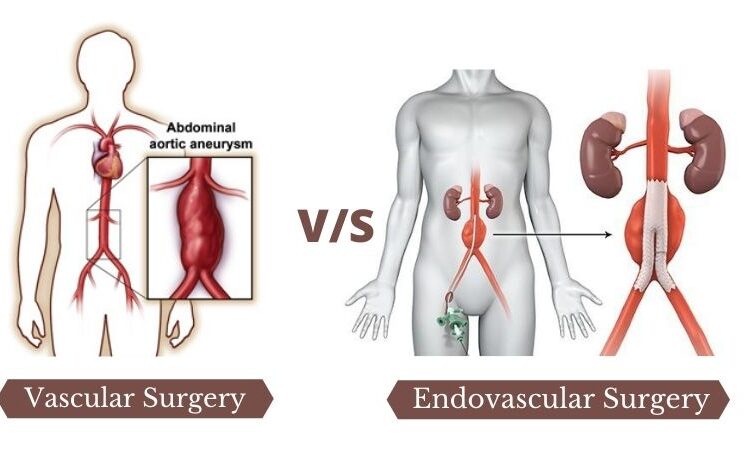Vascular surgery is the technique to correct blood vessels outside the heart and brain that has narrowed, blocked or dilated. Vascular surgery is actually the open-surgical treatment of diseases of the mesenteric, renal, aortic, carotid and peripheral arteries. Anesthesia is given to the patient to correct these problems of the patient using this surgery.
Endovascular surgery is the alternative to traditional open surgery – vascular surgery. This is an innovative, less-invasive procedure that offers advantages like small incisions, les pain, shorter hospital stays, and quicker return to normal activities. However, endovascular surgery is not always possible for all patients, according to the patients’ condition the physician will tell what surgery will be the best for them. That’s why it is always good to consult a physician or directly a vascular surgeon.
This is the basic difference between vascular and endovascular surgery. But, due to the numerous advantages of endovascular surgery most patients wants to go through this. But, it depends on the patients’ condition that what will be appropriate for him/her. Hence, one should always consult a vascular surgeon in Delhi to know more about the treatment. And if you want to know what is endovascular surgery and what it’s process then read the blog till the end.
Endovascular Surgery
The surgeon make small incision near each hip so that they can access the blood vessels. Then a special fabric tube device known as endovascular graft, is inserted through the arteries in a catheter. Placed inside the aorta. Once in place, the graft expands and seals off the aneurysm. This prevents the blood from flowing into the aneurysm. And the endovascular graft will remain in the aorta permanently.
Earlier this was treated by open surgery, involving incision in the side of the chest or breastbone which was used to take long time to recover. The patients have to stay in the hospital for 10-12 days following an open surgery and then undergo a three-month recovery. Endovascular surgery is actually the alternative to open surgery, which offers so many advantages to the patients.
Advanced Endovascular Procedures
Standard endovascular repair is not always appropriate for every patients, there are some cases when the surgeons has to go with open-surgery only. Sometimes the case is too complicated for the surgeons to use endovascular surgery. In that case they have three options – open surgery, complex endovascular repair or no treatment.
The expert vascular surgeons have developed the new procedures and technologies in this regard. Using endovascular techniques for complex conditions. These advanced may be used for thoracoabdominal aortic aneurysms (TAAA) that involve vital arteries to the abdominal organs, or arch aortic aneurysms, involving vital arteries to the brain.
Preparation
The first step is to meet your doctor or surgeon. He will check your medical history and conduct a thorough physical exam. This will be done to know what treatment would actually be the best for you. He also test your heart like stress test and an electrocardiogram (ECG), which records the electrical activity of the heart. Your doctor will also check whether your aneurysm can be treated with endovascular surgery or not. For which he will has some tests, including a CT scan and angiography. He will then discuss everything with you and will answer all your questions you have related to the disease and surgery.
Procedure
To start the procedure of endovascular surgery, either a sedative and regional anesthesia will be given to you to make you more comfortable and numb the area of operation. Or, the general anesthesia that will put you to sleep completely. To prevent infection the area of insertion will be cleaned or shaven before the surgery. Then the surgeon will make a small incision around the hipto access your blood vessels. Through the incision a guide wire will be inserted and pushed through a blood vessel to the aneurysm.
After this special x-rays will be taken by your doctor/surgeon so that he can see the exact location of the aneurysm. At this point the doctor will insert a catheter (a long, flexible thin tube) over the guide wire. When the graft will reach to its place in the aorta above the aneurysm, released from the catheter it will expand to block the flow of blood to the aneurysm.
Recovery
After recovery you will be closely monitored and cared by the team of expert healthcare professionals. Usually it takes two to three days in the hospital, later you will be discharged. On the first day following surgery you will be allowed to walk and eat. However, most patient experience the feeling of low energy and appetite for almost two weeks post operation.
You are allowed to take sponge bath for a few days but make sure not to soak the area around your incision until it has completely healed. Most patients are able to return to their normal activities within four to six weeks after surgery.
Follow Up
If you think after the surgery you will be recovered immediately then it’s not completely true. After the surgery you will have a follow-up appointment with your doctor for one or two weeks. Your doctor will check the progress of your recovery and also prescribe the required medicine and exercises that will elevate the recovery process. One and six months following surgery you will be tested by the doctors to check the graft is functioning or not.
Complications
Endovascular surgery also have potential complications like any other procedure, which may include:
- Fever and an increase in white blood cell count shortly after the surgery
- Blockage of the blood flow through the graft
- Infection
- Graft fracturing
- Movement of the graft away from the targeted position
- Leaking of blood around the graft
Other complications that are rare, but serious may include:
- Burst artery
- Blocked blood flow to the abdomen or lower body
- Injury to kidneys
- Delayed rupture of the aneurysm
- Paralysis

